Paleo and Rock Magnetism

Magnetically shielded room
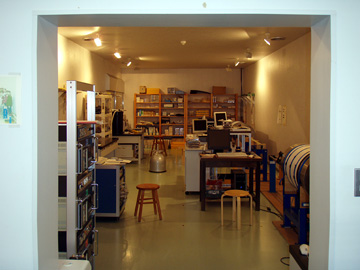
| Marine cores consist of rocks and sediments, which contain a variety of magnetic particles. These rocks and sediments acquire remanent magnetizations in response to the Earth's magnetic field at their formation or deposition, and the magnetizations are preserved over geological time as `fossils'. One can determine (calculate) the fossil magnetizations by measuring magnetic field produced by them. Fossil magnetizations preserved in rocks and sediments are generally very weak and thus magnetic field produced by them is also very weak. 'Magnetically clean' environment is necessary to detect and measure this very weak field. The Kochi Core Center has a magnetically shielded room which is surrounded by three layers of permalloy metals (alloys of iron and nickel). The residual field inside the room is about 0.2 per cent of the field outside and the room is one of the biggest `shielded rooms' in the world. A variety of instruments are placed in this shielded room: pass-through superconducting magnetometers; spinner magnetometer; kappa bridge; thermal and AF demagnetizers. |
Pass-through Superconducting Magnetometer for U-Channel Samples
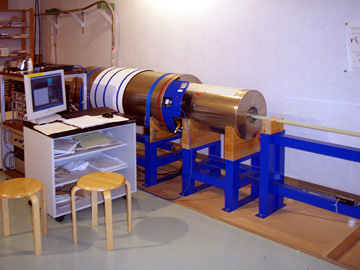
| This instrument utilizes high-sensitivity superconducting quantum interference device (SQUID) sensors which are capable of measuring very weak magnetizations recorded in geologic materials. One can measure remanent magnetizations with stepwise AF demagnetization treatments on a fully automatic basis, including applications of artificial remanence in laboratory (ARM). It is tailored to continuous measurements of U-channel samples, but measurements of discrete samples are also possible. | ||||||||
| Model | ||||||||
|---|---|---|---|---|---|---|---|---|
| Model 760R (U-channel), 615L | ||||||||
| Manufacture | ||||||||
| 2G | ||||||||
| Operating condition | ||||||||
|
||||||||
| Lab. | ||||||||
| Paleo & Rock Magnetism |
MPMS
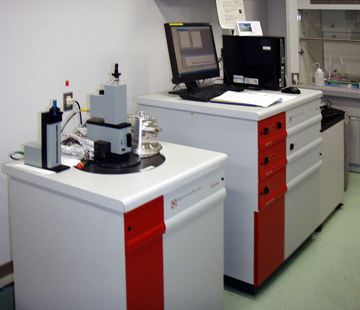
| The magnetic property measurement system (MPMS) measure magnetizations and magnetic susceptibilities of samples using SQUID sensors under controlled magnetic field and temperature. Magnetic field is created by a built-in superconducting magnet and temperature is controlled by evaporated liquid helium. It is often used to determine the types of magnetic minerals contained in the sample by detecting sub-room-temperature phase transformations characteristic to individual magnetic minerals (e.g. 110 K Verwey transition of magnetite). | ||||||||
| Model | ||||||||
|---|---|---|---|---|---|---|---|---|
| MPMS-XL5 | ||||||||
| Manufacture | ||||||||
| Quantum design | ||||||||
| Operating condition | ||||||||
|
||||||||
| Lab. | ||||||||
| Paleo & Rock Magnetism |
VSM

| Vibration of a sample in a steady magnetic field induces electromotive force in vicinity coils. The vibrating sample magnetometer (VSM) measures magnetization of the sample by amplifying the induced electronic signals in the coil. One can control dynamically the magnetic field and temperatures so that it is possible to obtain magnetic hysteresis loops (M-H curves) and thermomagnetic curves (M-T curves). | ||||||||
| Model | ||||||||
|---|---|---|---|---|---|---|---|---|
| MicroMag 3900 | ||||||||
| Manufacture | ||||||||
| Princeton Meas. Co. | ||||||||
| Operating condition | ||||||||
|
||||||||
| Lab. | ||||||||
| Paleo & Rock Magnetism |
Magnetic Balance
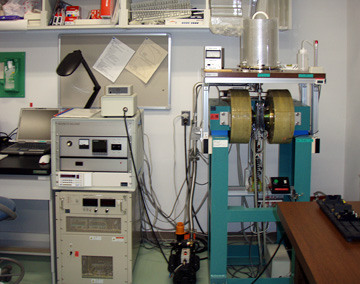
| This instrument enables thermomagnetic experiments. One can obtain thermomagnetic curves (M-T curves) and determine the Curie temperature of a sample. | ||||||
| Model | ||||||
|---|---|---|---|---|---|---|
| NMB-89 | ||||||
| Manufacture | ||||||
| Natsuhara-Giken | ||||||
| Operating condition | ||||||
|
||||||
| Lab. | ||||||
| Paleo & Rock Magnetism |
Kappa Bridge

| One can measure magnetic susceptibility and its anisotropy of core samples. | ||||
| Model | ||||
|---|---|---|---|---|
| KLY-3S | ||||
| Manufacture | ||||
| Agico | ||||
| Operating condition | ||||
|
||||
| Lab. | ||||
| Paleo & Rock Magnetism |
Spinner magnetometer
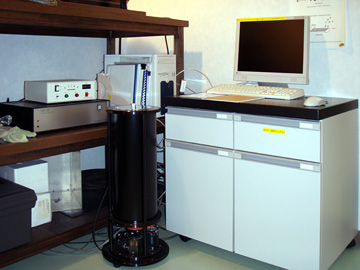
| This instrument enables measurements of remanent magnetization of igneous and metamorphic rocks which generally have strong magnetizations, by rotating samples around several flux-gate magnetometers. Remanent magnetizations of some sedimentary rocks are also measurable. | ||||
| Model | ||||
|---|---|---|---|---|
| SMD-88 | ||||
| Manufacture | ||||
| Natsuhara-Giken | ||||
| Operating condition | ||||
|
||||
| Lab. | ||||
| Paleo & Rock Magnetism |
Thermal demagnetizer
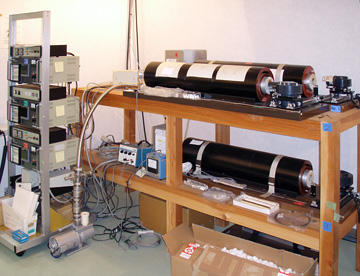
| This is a specially designed electronic furnace, sample space of which is surrounded by three layers of permalloy metals. One can thermally magnetize and demagnetize samples. | ||||||
| Model | ||||||
|---|---|---|---|---|---|---|
| TDS-1 | ||||||
| Manufacture | ||||||
| Natsuhara-Giken | ||||||
| Operating condition | ||||||
|
||||||
| Lab. | ||||||
| Paleo & Rock Magnetism |
Alternating Field (AF) demagnetizer

| There are three layers of permalloy metals outside the sample space, and a sample is set to a two-axis tumbler which rotates inside an AF-generating coil. One can iso-thermally magnetize and demagnetize samples utilizing AF field. | ||||
| Model | ||||
|---|---|---|---|---|
| DEM-95 | ||||
| Manufacture | ||||
| Natsuhara-Giken | ||||
| Operating condition | ||||
|
||||
| Lab. | ||||
| Paleo & Rock Magnetism |


